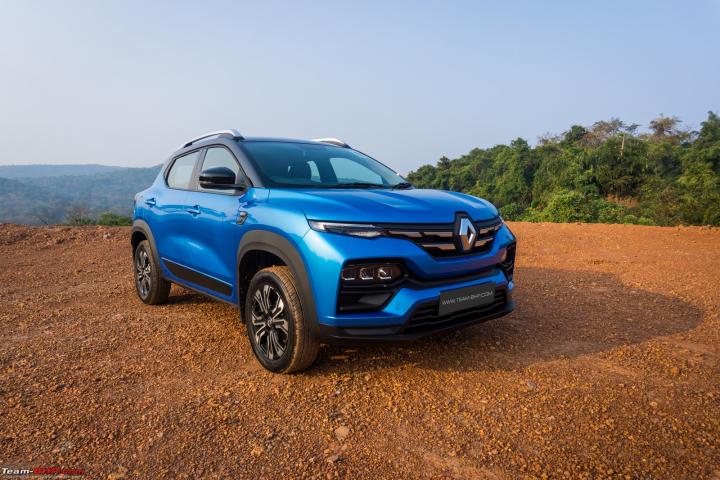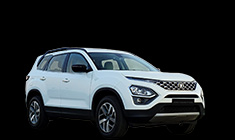News
Renault Kiger 2021: 51 observations after a day of driving
With the Kiger, Renault has a genuine shot at shooting past Toyota & Honda and doing 13,000 - 15,000 sales / month. The Kwid & very intelligent Triber already bring in a couple of thousand sales each month, while the Kiger will only add to that tally further. The Kiger is the Nissan Magnite's close sibling and the two are almost the same under the skin.
Renault Kiger 1.0L Turbo-petrol Driving Report
With the Kiger, Renault has a genuine shot at shooting past Toyota & Honda and doing 13,000 - 15,000 sales / month. The Kwid & very intelligent Triber already bring in a couple of thousand sales each month, while the Kiger will only add to that tally further. The Kiger is the Nissan Magnite's close sibling and the two are almost the same under the skin.
The Kiger is offered with two engine options – a 1.0L, 71 BHP naturally aspirated petrol and a 1.0L, 99 BHP turbo-petrol. Both are offered with a 5-speed manual transmission as standard and get the option of an AMT for the naturally aspirated version or a smooth CVT for the turbo-petrol. Ex-showroom prices start at Rs. 5.45 lakh for the base variant and go up to Rs. 9.55 lakh for the top-end 1.0 turbo-petrol CVT (related news).
I got to drive the Renault Kiger 1.0L turbo-petrol with the 5-speed manual transmission at the media drive in Goa. Here are my quick and brief observations:
- If you found the Nissan Magnite a little quirky in its appearance (I personally did), then the Kiger is probably good news for you. Looks are of course subjective, but I will say that the Kiger is the more handsome one to my eyes. And it does look modern.
- Renault has gone for a coupe-SUVish look with a sloping roofline and a rising window line which make it look more like a beefed-up hatchback.
- While the overall build quality is satisfactory, you can tell that the car is built on a budget. The doors are not heavy and there is some flex in the body panels. But at this price point, it is acceptable.
- All variants get 16-inch wheels with only the top-end RXZ variant wearing alloys. They are shod with 195/60 R16 Ceat SecuraDrive tyres. The spare is a 15-inch steel rim with a 185/65 tyre.
- Step inside and you're greeted by a pleasant cabin design with subtle modern touches. You will also notice the Renault diamond logo theme across the cabin (seat covers, door pads, etc).
- Plastics are hard as you would expect at this price point, but they don't scratch that easily. Yes, it feels budget-friendly, yet not cheap.
- A/C control switches and buttons on the center console are backlit, which is a very nice touch. You also have a switch on the center console for ambient lights!
- Getting in and out of the car is more like in a raised hatchback - easy. You will need to watch out for the edge of the roof while getting out though. Once inside, the cabin width is adequate and it does feel reasonably spacious. There's decent headroom in the front as well as rear. Even with the seat all the way back, there's enough legroom for the rear passenger.
- The front seats are draped in black fabric and the top-end variants get side airbags in them, so don't use seat covers. The seats look great and overall support is satisfactory. Not the best out there, but comfortable for the most part.
- The steering is adjustable for height. The driver's seat is adjustable for height too and has a good range. Finding your perfect driving position in this car isn't difficult.
- Ergonomics are good (unlike some of the old Renaults with their French quirks). Everything is easy to reach in the cabin, and you'll feel right at home as soon as you get in the driver's seat.
- The big 7-inch instrument cluster is easy to read and very detailed. A unique feature here is that the screen displays different information in different drive modes. Sport mode includes HP and Nm meters along with a G-Force meter.
- Frontal visibility is good, but if you like being seated low, the A-pillar and ORVM will form a sizeable blind spot. The IRVM is small and thick C-pillars further restrict the rearward visibility.
- Space utilisation & practicality in the Kiger are just excellent. For starters, all 4 doors can hold a 1L bottle with some space left over for other knick-knacks.
- You have 2 glove boxes on the dashboard with a total volume of 14.9 liters. The center console has about 7.5 liters of storage space in it. Note, the cupholder tray is removable.
- One of the most noteworthy features is the wireless smartphone integration (Android Auto and Apple CarPlay).
- Another interesting feature is that the air-conditioning gets an inbuilt PM 2.5 air filter. There's also a proper air filter available as an accessory.
- The RXT and RXZ variants get an 8-inch touchscreen. The touchscreen has a simple layout. It's not cluttered with unnecessary functions and settings, so finding something you actually need is quite easy.
- The screen has a sort of matte finish on it which doesn't leave a lot of fingerprints. One gripe with the screen however, is that the buttons on the side are screen-integrated and not physical buttons which are so much better for basic operations (i.e. you don't have to take your eyes off the road to operate them).
- Rear view camera display on the screen is good. You can also adjust the brightness, contrast and saturation of the display.
- The sound quality from the (4 speaker + 4 tweeters) Arkamys system is fair for the price. One strange behaviour I noticed with my phone was, while playing songs through Bluetooth (not wireless CarPlay), the volume level was half. Had to crank it up to full for the song to be audible. Worked well in all other scenarios (radio and CarPlay). Weird.
- The rear seats are placed at a comfortable height, so even elderly folk will find it easy to get in and out of the car. While the seats themselves are comfortable, I found the backrest angle to be too upright for my liking.
- On the rear seat, I felt I would be comfortable with a little more under-thigh support (I'm 5'10" tall). That said, shorter & medium-height folk would be quite comfortable.
- There's a good amount of headroom and knee room. Behind my own driving position, I had a few inches of knee room. Even with the front seat pushed back all the way, it wasn't too bad (similar experience to an economy flight seat). That's saying a lot for a compact car!
- Seating three people abreast will be a task. The floor hump is small and not intrusive.
- You get a nice and wide armrest with two cupholders and a phone holder. You also get rear A/C vents and a 12V charging socket.
- Adding to the excellent space utilisation, the Renault Kiger has the biggest boot in the segment at 405 liters. The rear seats are split in a 60:40 ratio. Folding the backrests down expands the boot space to 879 liters. The loading lip, however, is high, so you will have to lift your luggage while loading. You'll find baggage hooks on the side and the spare wheel has been placed beneath the boot floor. No boot lamp provided, which is a very obvious and sad omission.
- The Kiger is powered by a 999cc, 3-cylinder turbocharged petrol engine. Called the HRA0, this engine produces 99 BHP and 160 Nm, which is healthy, although there are rivals that offer more power. The car's light kerb weight makes it agile on its feet and there is enough grunt in this motor to keep most drivers happy.
- If you want to know how the CVT drives, click here (same engine & CVT in the Magnite) and read the second half of that post.
- On startup, being a 3-cylinder, there is slight body shake and a few vibrations do come into the cabin. Faint vibes are felt on the steering, pedals and the driver's seat.
- The turbo-petrol has a fair low-end and yes, the car clears the 2nd gear speed breaker test; it's certainly not dead off-boost. Some lag is there of course, yet it's well-controlled. That said, you have to be a little patient when pulling from low rpms in 2nd gear.
- Mid-range is punchy. So, keep the engine on the boil and you can have some fun with this car.
- The engine revvs till 6,500 rpm, but not happily as it groans & moans at the redline in a very crude manner. By this point, power has started tapering off and you will have already shifted up.
- Driveability is good and you won't find the need to downshift often, although there is some lag in the higher gears.
- In 5th gear, the car can cruise at 100 km/h & 120 km/h @ ~2,300 rpm & ~2,900 rpm respectively.
- Unlike the Magnite 1.0 MT, the Kiger gets 3 driving modes - Normal, Eco and Sport. These modes alter the throttle response and steering weight. There's not much difference in the Eco and Normal mode, where the steering is light and throttle response is slightly dulled down. In Sport mode, the steering is noticeably firmer and throttle response is quick as well.
- 5-speed gearbox offers a poor shifting experience. I found the shift action to be quite clunky and it requires some effort to use. My suggestion = go for the smooth CVT automatic.
- The clutch pedal too has some weight...more weight than you'd expect in such a small car. Also, the travel is long and the bite point is high. Moreover, off standstill, it's not that smooth.
- Coming to NVH levels, the Kiger does well at slow speeds and around town. Upon revving, you can hear that familiar 3-cylinder thrum. Yet, this noise is not excessive. Even while cruising on the highway, the engine is audible, but not irritatingly so. It's above 5,000 rpm that the motor gets loud.
- In such a cheap car, I would have expected wind & road noise to be excessive, but no. The cabin is acceptably insulated.
- The ride quality of the Kiger appears to be better than the Magnite. Where the Magnite was very firm, the Kiger is more absorbent. While there is a hint of underlying firmness to the suspension at low speeds, it's not excessively so.
- On a rough patch of road, I found myself doing good speeds without any issues. You can hear the suspension working, but little is transmitted into the cabin.
- On the open road, straight-line stability at high speeds is satisfactory. The car doesn’t feel twitchy over bumps & undulations.
- Coming to handling, the Kiger behaves like a normal family crossover. While there is some body roll, it's not excessive. You can even hustle the car through a series of twisty roads confidently.
- Grip from the 195/60 Ceat SecuraDrive tyres is acceptable for the average Mahesh. Push hard and the tyres start chirping.
- The electric power steering is light and smooth in Normal / Eco modes at parking & city speeds. Along with the small size, this makes the Kiger a very easy car to drive in urban conditions.
- While Sport mode adds weight to the steering, it feels artificial. There's vagueness in the center and you don't feel very connected if you're driving hard in the ghats. Good for highways & high speed though.
- The Kiger comes with an unladen ground clearance rating of 205 mm, which is second only to the Tata Nexon (209 mm). This is more than enough to take on the worst of Indian roads.
- The Kiger is equipped with disc brakes at the front and drums at the rear, with ABS + EBD. The brakes perform as expected. Do note that the second half of the brake pedal travel is quite sensitive, this will take a couple of km to get used to.
- The list of safety features in the Kiger isn't as long as the Magnite. Major misses from the Nissan include ESP, traction control and hill-start assist. Even the Datsun Go and Go+ get ESP. This is a disappointing omission on Renault's part!
- On the flip side, the Kiger gets 4 airbags (Magnite gets only 2) and front parking sensors (as an added accessory). The Kiger hasn't been crash-tested yet, but the Nissan Magnite scored a 4-star rating in the ASEAN NCAP crash tests. We expect the Renault to perform similarly.
Continue reading the discussion on the 2021 Renault Kiger on our forum.






















